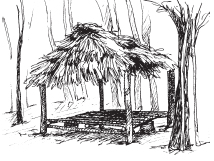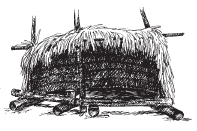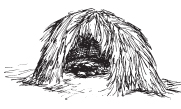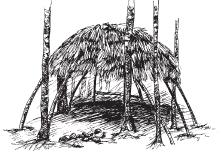
THE ORCOQUIZA/AKOKISA INDIANS
Name
The name Akokisa is of unknown origin, although John R. Swanton has speculated
that the name may be from the Atakapa word icak meaning "person".
The Akokisa have also been known by the following names (and spellings): Accockesaws,
Accokesaus, Accokesaws, Aco-ke-sas, Arkokisa, Horcoquisa, Ocosaus, Orcoquisa(s),
Orcoquisacs, Orcoquizas.
History
The Akokisa were the indigenous tribe of Atakapan-speaking Indians who lived in and around what is now the Houston Skyline district in an area including Galveston Bay and the lower Trinity and San Jacinto rivers in Texas. It seems likely that the Han and Coaque Indians encountered by Spanish explorer Álvar Núñez Cabeza de Vaca in the early sixteenth century were Akokisas, as well as the Caux, who held Simars de Bellisle captive in the early eighteenth century. Bellisle's account of his captivity provides some information about Akokisa culture. John Sibley in 1805 reported that they previously lived near Matagorda Bay on the west bank of the Colorado River in ancient times. Most of what is known about the Akokisas comes from mission records. In 1748-49 some of them entered San Ildefonso Mission on the San Gabriel River near the site of present Rockdale, but they left this area when the mission was abandoned in 1755. Nuestra Señora de la Luz Mission was built near the mouth of the Trinity River for the Akokisas and the Bidais in 1756-57 and lasted until 1772. Thereafter little is reported about the Akokisas, although in 1805 they seem to have lived in two settlements, one on the lower Colorado River and the other near the coast between the Neches and Sabine rivers. It seems likely that the Akokisa survivors joined their relatives, the Atákapas, in southwestern Louisiana shortly before the Texas Revolution.
Culture
Akokisa people lived in settled villages and built airy structures to cope with
their warm climate. Their homes were beehive-shaped and thatched with grass
or palmetto leaves. A hearth would be located in the center of the floor with
a smokehole in the ceiling. During summer months, an Akokisa would sleep in
a Chickee, a raised platform with a thatched roof and open sides. Beds were
made of straw, covered with animal skins.
For water transportation and fishing, Akokisas carved cypress logs into dugout
canoes.
Both men and women decorated their bodies and faces with tattoos.
The Akokisa, like the Atakapa, practiced cannibalism, which may have been connected
to their religious beliefs. Cannibalist feasts were described by Simars de Bellisle,
who observed them firsthand. Black drink was used for purification in certain
ceremonies.
They are reported to have grown "superfine" maize. Tubers of the Greenbrier
vine provided meal for baking and cooking.During warm seasons they ate bird eggs,
fish, shellfish, and American lotus rhizomes and seeds; during cold seasons they
moved further inland and hunted deer, bear, and buffalo. Horses were used to
hunt buffalo. Tanned deer hides and bear fat were their primary commercial exports.
Almost nothing is known about their kinship systems, life cycle, or marriage
customs.
Language
The Akokisa language is extinct and virtually unknown. Swanton claimed that the
Akokisa spoke a language related to Atakapa based on the similarity of a vocabulary
of 45 words ascribed to the Akokisa collected by Captain Jean Béranger
in 1721 on Galveston. However, there is no clear evidence that this document
actually represents the language of Akokisa (Béranger provides a tribal
designation for the vocabulary). Sibley also reported that they had their own
language "peculiar to themselves" and used sign language to communicate
with other Indians (also reported for other peoples in eastern Texas). He did
not connect them with the Atakapa. Only two Akokisa words have been found in
Spanish records: Yegsa meaning "Spaniard(s)" and Quiselpoo, a female
name.
The Akokisa Indians in Houston History
Harris County Precinct 4 Jesse Jones Park and Nature Center
From the Akokisa Indian Village Information Page http://www.hcp4.net/jones/akokisa.htm
Early 18th century Spanish, French, and Anglo explorers found about 3,500
Akokisa (or Orcoquisa) Indians living in Chambers, Galveston, Harris, and Liberty
counties,
and a major Akokisa village was located just across Spring Creek from Jones
Park. The Akokisas were skilled at making dugout canoes from cypress logs and
used them on nearby waterways for fishing and transportation. They were also
noted for their excellent hide tanning skills, especially bearskins, and their
use of native plants for medicinal purposes.
By the 1850s most of the Akokisas had merged with other American Indian tribes
or died from European diseases to which they had no immunity.
Hut
The Akokisas lived in palmetto or grass-thatched roundhouses. In winter, they
occasionally added animal hides and a small fire for warmth. Woven mats served
as seats and beds. A smoke hole at the top would serve as a chimney. In most
Gulf Coast Indian groups, the women, not the men, owned the property.

Chickee
In the summer, the Akokisa and many other southern American Indian groups lived
in a "chickee," an open-sided structure with a raised platform that
allowed them to sleep above ants and other insects. A bed of soft straw would
be made on the platform and covered with skins for sleeping. During mosquito
season, a small smudge fire underneath the platform would sift through the
platform and repel mosquitoes. They also smeared their bodies with rancid alligator
fat as a mosquito repellent.

Lean-to
The Akokisas often built easily constructed, open-sided structures for work
areas while traveling. Pictured here is the lean-to where hides were worked
into clothing, tools and weapons were made, or food was prepared. The brush
arbor, opposite the lean-to, has hide-tanning racks and provides a breezy
work space where such tasks as basket weaving, mat making, and child care
would
have taken place.

Sweat Lodge
Every American Indian village had a sweat lodge for both health and religious
purposes. Here they might seek inspiration and guidance for an upcoming
adventure through a dream or vision of a totem animal. Like modern saunas,
respiratory
and other ailments were likely treated here.

Council Lodge
The council lodge was the focus of community life and rituals. Matters of
general interest would be discussed here, and tribal history and legend
would be passed
on through story, song, and dance. Oral tradition filled the gap of written
language, as the elders would tell tales of the past.

San Jacinto River Authority--The historic San Jacinto saw the birth of Texas when Sam Houston defeated Mexican General Santa Anna in the Texas Revolutionary War in 1836 along its banks. For many centuries before, Akokisa Indians camped along her banks, in later years trading with Cabeza de Vaca and other explorers. The river saw an overnight tent city spring up in Humble when two men discovered oil gurgling from its banks –which started the company Exxon.. Ecologically, the river forms the western edge of the ‘Big Thicket’, a forest ecoregion unique enough to be dubbed a U.N. Biosphere Reserve due to its extremely high biodiversity.
Houston Chamber of Commerce-The original inhabitants of North Harris County were Indians of the semi-nomadic tribe of Akokisa (also called Orcoquisac) Indians. They were a small tribe of under a few thousand that roamed in family groups fishing along the coast until winter when they congregated along Spring Creek to hunt deer, bear and buffalo.
U.S. Forestry Service-Sam Houston National Forest- The three counties
that contain the Sam Houston National Forest - Montgomery, San Jacinto, and
Walker
- have
yielded
evidence of human occupation dating
back 12,000 years. More recently, the basins of the San Jacinto and Trinity
River were home to Atakapan-speaking groups known as the Bidai, Patiri, Deadose,
and Akokisa.
The Akokisa were the indigenous tribe that lived on Galveston Bay and the lower
Trinity River and San Jacinto River rivers in Texas. Primarily hunters and gatherers,
some from these groups may have practiced some
form of
agriculture. Disease and oppression from European settlers led to
their eventual extinction in the early 1800s. Evidence of occupations from as
early as 7,000 years ago to the twentieth century has been documented by a number
of archaeological sites within the national forest.
Wallisville Lake Project Akokisa Indian Archeological Sites-Project
Area History: 187 archeological sites are recorded on Wallisville Project lands
dating from about 1700BC through
the mid twentieth century. Two areas
are listed as National Historic Register Districts: Orcoquisac Archeological
District and the Old Wallisville Townsite. In 1984, 19,700 acres of the Wallisville
Project were determined eligible as a National Register District. 164 of
the archeological sites are shell middens and 23 sites are from the presidio,
mission,
town site, and home sites scattered across the Project. No other area along
the Texas coast has been so thoroughly inventoried for existing archeological
sites. The shell midden sites primarily consist of rangia clam and/or oyster
shells discarded by the early Native Americans who used the clams and oysters
as staple food sources. Akokisa, Arkikosa, and Orcoquiza are alternate
spellings of the names used for these Native American peoples. In 1756
AD the Spanish established Presidio San Luis Agustin de Ahumada del Orcoquisac
and Mission
Nuestra Senora de la Luz to help prevent French settlement and trading with
the Orcoquiza and Bidai who were living in the area at that time. The Presidio
was garrisoned with Spanish troops through 1771. It was officially abandoned
in 1772. The missionaries were the last persons to leave the site.